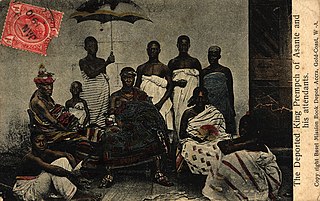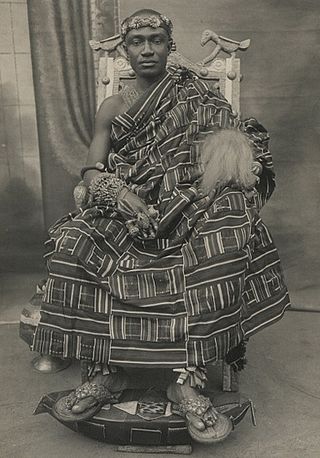Osei Kofi Tutu I was one of the founders of the Ashanti Empire, assisted by Okomfo Anokye, his chief priest and a distance relative from the town of Awukugua - Akuapem. The Asante comes form the Akan ethnic group of West Africa. Osei Tutu I led an alliance of Asante states against the regional hegemony, the Denkyira, completely defeating them. He ruled the Kumaseman State between c.1680/c.1695-1701 and he ruled the Ashanti Empire from late 1701-c.1717.

Osei Tutu II is the 16th Asantehene, enstooled on 26 April 1999. By name, Otumfuo Osei Tutu II is in direct succession to the 17th-century founder of the Ashanti Empire, Otumfuo Osei Tutu I. He is also the Chancellor of the Kwame Nkrumah University of Science and Technology. Otumfuo Osei Tutu II is the Grand Patron of the Grand Lodge of Ghana and the Sword Bearer of the United Grand Lodge of England.
Okomfo Anokye (c.1655-c.1717?/c.1719) was the first priest (Okomfo) of the Ashanti Empire. Anokye is known for his participation in the expansion of the empire. He was also the codifier of the constitution and laws of the Ashanti Empire.
Opoku Ware I was the 2nd Asantehene of Oyoko heritage, who ruled the Ashanti Empire. Between 1718 and 1722, Opoku Ware became Asantehene during a period of civil disorder after the death of the 1st Asanthene. From 1720 to 1721, Opoku established his power.

The Golden Stool is the royal and divine throne of kings of the Ashanti people and the ultimate symbol of power in Asante. According to legend, Okomfo Anokye, High Priest and one of the two chief founders of the Asante Confederacy, caused the stool to descend from the sky and land on the lap of the first Asante king, Osei Tutu. Such seats were traditionally symbolic of a chieftain's leadership, but the Golden Stool is believed to house the spirit of the Asante nation—living, dead and yet to be born.

The Akyem are an Akan people. The term Akyem is used to describe a group of four states: Asante Akyem, Akyem Abuakwa, Akyem Kotoku and Akyem Bosome. These nations are located primarily in the eastern region in south Ghana. The term is also used to describe the general area where the Akyem ethnic group clusters. The Akyem ethnic group make up between 3-4 percent of Ghana's population depending on how one defines the group and are very prominent in all aspects of Ghanaian life. The Akyem are a matrilineal people. The history of this ethnic group is that of brave warriors who managed to create a thriving often influential and relatively independent state within modern-day Ghana. When one talks of Ghanaian history, there is often mention of The Big Six. These were six individuals who played a big role in the independence of Ghana. Of the big six, people of Akyem descent made up the majority.
Akyem Abuakwa is one of the four states of Akyem in 14th century Africa. Currently, it is part of Ghana. Historically, the Akyem were part of the Adansi Kingdom, which was the first nation to build buildings out of mud. They were therefore were named Adansi (builders). In the 18th century, the Ashanti Empire emerged, and under the leadership of King Osei Tutu, defeated the Adansi and annexed them into the Ashanti Empire. The three Akyem nations that were part of the Adansi Kingdom seceded and crossed the River Pra.

The Asante Empire, today commonly called the Ashanti Empire, was an Akan state that lasted from 1701 to 1901, in what is now modern-day Ghana. It expanded from the Ashanti Region to include most of Ghana as well as parts of Ivory Coast and Togo. Due to the empire's military prowess, wealth, architecture, sophisticated hierarchy and culture, the Ashanti Empire has been extensively studied and has more historic records written by European, primarily British, authors than any other indigenous culture of Sub-Saharan Africa.

Prempeh I was the thirteenth king ruler of the Ashanti Empire and the Oyoko Abohyen Dynasty. King Prempeh I ruled from March 26, 1888 until his death in 1931, and fought an Ashanti war against Britain in 1893.

Otumfuo Opoku Ware II was the 15th Asantehene. He succeeded his uncle Osei Tutu Agyeman Prempeh II on the 27th July 1970. He ruled for 29 years until his death in February 1999. He was succeeded by Otumfuo Nana Osei Tutu II.

The Asante, also known as Ashanti, are part of the Akan ethnic group and are native to the Ashanti Region of modern-day Ghana. Asantes are the last group to emerge out of the various Akan civilisations. Twi is spoken by over nine million Asante people as a first or second language.

The Manhyia Palace is the seat of the Asantehene, as well as his official residence. It is located at Kumasi, the capital of the Ashanti Region. The first palace is now a museum. Otumfuor Opoku Ware II built the new palace, which is close to the old one and is used by the current Asantehene, Otumfuor Osei Tutu II.
Juaben is a small town in the Ejisu-Juaben Municipal District, a district in the Ashanti Region of Ghana.

Prempeh II, was the 14th Asantehene, or king of the Ashanti, reigning from 22 June 1931 to 27 May 1970.
Opoku is both a given Akan name and a surname. Notable people with the name include:
Nana Afia Kobi Serwaa Ampem II was the Queen mother (Ohemaa) of the Ashanti Kingdom and mother of the current Asantehene, Otumfuo Nana Osei Tutu II, who is the youngest son of her five children. She was the 13th Queen mother of the Ashanti Kingdom.
Osei Bonsu was a Ghanaian sculptor and practitioner of Ashanti carving.
Konadu Yaadom, also Kwadu Yaadom was the fourth Asantehemaa of the Asante, whose multiple marriages and spiritual influence meant that she became an important and powerful ruler in the eighteenth and early nineteenth centuries.

Oheneba is a regal rank given to both female or male child of a king or chief. It is the equivalent of prince or princess.
















